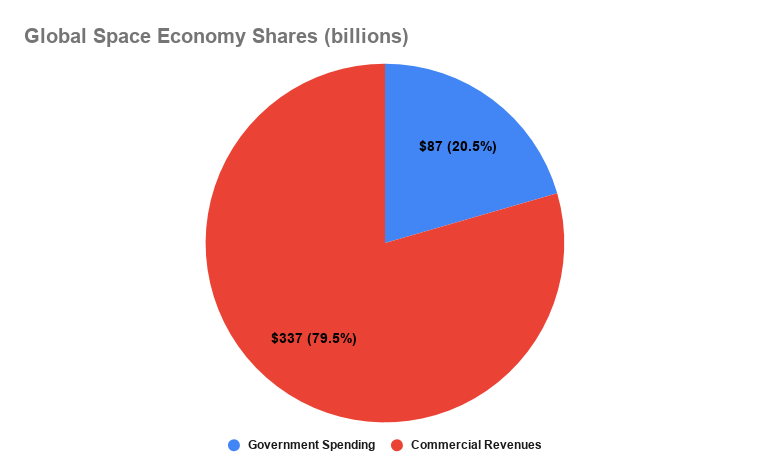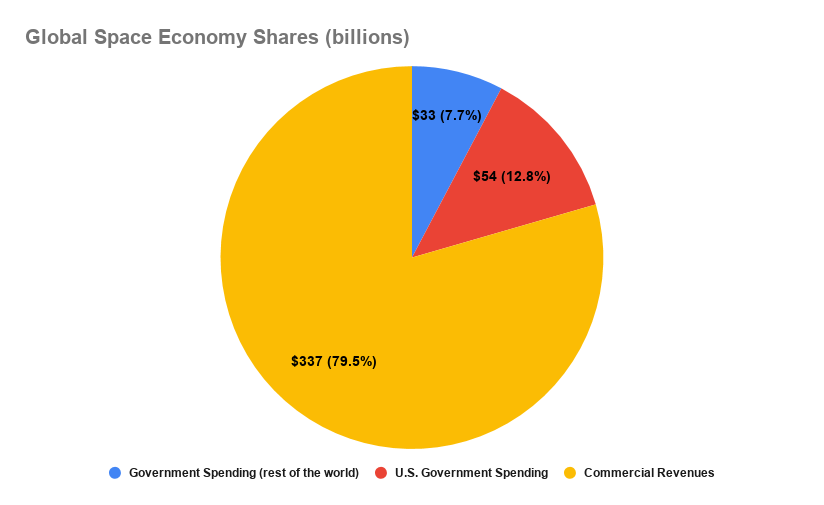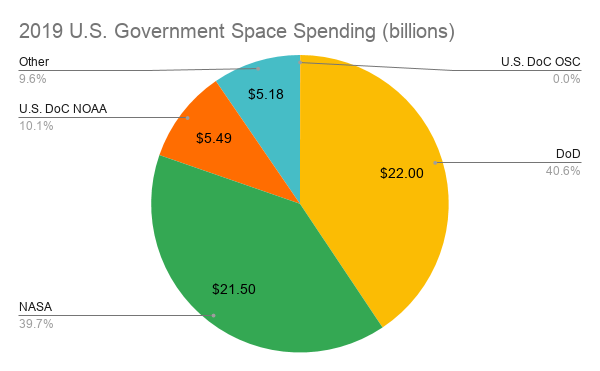Government Space Budgets=Industry Priorities (Where’s Commercial?)

The commercial space industry appears to be in a renaissance. It’s the strongest it’s ever been. It’s making more money than ever. At least, that's the common story for today's space sector. And last week the official champion of the U.S. commercial space industry, the Department of Commerce (DoC), just received,, a small boost for one of its space missions from a report.
The report’s upshot is that the DoC’s Office of Space Commerce (OSC) is the best qualified (of agencies suggested) to assume the critical role of running Space Traffic Management (STM). The report reinforces an STM mandate the White House already bestowed on OSC. The big obstacle to OSC’s mandate so far? Congress and its lack of funding for OSC and in this case, the STM mandate.
This lack of interest in STM is just an extension of legislator's seeming lack of interest in backing an, organization tasked with, implementing:
"...reforms of the U.S. commercial space regulatory framework that will unshackle private space industry."
Odd behavior in an age when many believe the U.S. commercial space industry is growing.
Follow the Money
While politicians have generally provided great lip-service for the U.S. commercial space industry, the money allocated to support the same industry is laughable. Let’s get into an example of U.S. government space spending estimates and priorities.
The Space Foundation’s latest research tells us the global space economy ,,grew--reaching ~$424 billion during 2019. The Space Foundation announced in late July that commercial space revenues for 2019 were ~$337 billion--about 79.5% of the global space economy. Civil and military spending from the world’s governments for space development, products, services, etc. took the remaining estimated 20.5% share (~$87 billion) of that $424 billion. Those numbers make it seem like commercial space revenues are growing.

Let’s focus on the share of government spending, specifically, the percentage of U.S. government spending (military and civil) for this article’s purposes. While the Space Foundation didn’t publicly share that, the combined U.S. military and civil space spending average share of the global space economy during the previous five years (2014-2018) was about 12.8%. Taking 12.8% from $424 billion comes to an estimated $54.2 billion of U.S. government space spending for 2019 (it’s probably a little less, as the last few years hovered between 11-12%).

Yes, these percentages indicate the Space Foundation estimates for space spending from the rest of the world’s governments add to an estimated $33 billion (probably higher, but likely less than $40 billion).
U.S. government departments, such as NASA, the Department of Defense (DoD) (typically quite closely split), and then NOAA (a DoC agency) generally are the government groups receiving significant shares of the U.S. government budget. At least seven other U.S. departments/offices receive a percentage of the budget--but their shares are so small compared to the first three, they truly aren’t worth mentioning.
NASA’s budget for 2019 was $21.5 billion (39.7%), meaning that based on historical Space Foundation estimates, the DoD (about half of its spending is classified) might have had a combined budget close to $22 billion (40%). I believe that DoD number is underestimated, taking into account the president’s focus on the U.S. Space Force. NOAA, a subordinate to DoC, received $5.49 billion (10.1%) for 2019. Seven other government agencies, such as the Department of Energy, the National Science Foundation, etc., share the remaining $5.18 billion.
In 2019, OSC received $1.8 million for its budget. That’s a .003% share of the entire U.S. government space budget in 2019. The next year, OSC didn’t get much more--around $2.5 million. Assuming the DoC is the champion for the commercial sector, it’s not receiving much financial support to be that champion.

"You Keep Using That Word, I Do Not Think It Means What You Think It Means"
And that word is “commercial” (the other misused word is “market”). When a government space program uses “commercial” in its title, that doesn’t mean it is catering to the commercial market. When a government agency is concerned about developing or maintaining a particular market, that prompted concern is because it needs specific services or products to get its job done.
The following are the primary U.S. government space spending categories supporting the U.S. space sector--civil (NASA) and military (the DoD). NASA and the DoD are spending their budgets on programs that support their activities (for the taxpayers’ benefit, of course). Considering the nation’s recent focus and promotion of the U.S. commercial space industry, the government support for that industry, based on the budget allocations, seems rather...old-space-oriented and non-commercial?
The budget allocations help explain some of the things happening in the U.S. space sector today. Both NASA and the DoD have attempted to implement programs to develop and support commercial space. However, their narrow focuses and the monetary resources they throw at the sector, distort the market, no matter how well-intentioned their programs are. Government mandates drive their narrow focuses, which are no substitute for free markets. For example, the ,,DoD is starting to use the rationale of protecting U.S. space commerce with its new Space Force. But space commerce needs to grow first.
But commercial space shouldn’t grow only because of government needs--those can really skew a company's offerings. NASA’s and the DoD’s big budgets are why startups such as Planet pursue those government-established focuses. There appears to be too much market distortion for the company to chase commercial customers alone. Even a more successful company, SpaceX, is pursuing government contracts and subsidies.
This situation and distortion are why the OSC needs to be funded more seriously--its focus would be the actual business of space--not national security, not space exploration and education--but business. It would be a resource for anyone involved in the space industry to turn to. It would be able to establish what a healthy space market actually is.
While throwing money at an agency is never really a right answer, there needs to be a foil, one based on commercial business practices, if the commercial space industry is to grow in the United States. The DoC’s OSC might be that foil. But .003% of the U.S. space budget shows that lawmakers aren’t serious about commercial space. At least not as serious as they are with civil and military space. That amount of money doesn't even buy OSC a key to commercial space's shackles.
The other path lawmakers should take is allocating less money to NASA and DoD space programs--maybe change the reasons for allocating money to those agencies. They are already far too influential, for purposes not conducive to growing a space economy.
The good news is, there is a commercial space industry in the U.S. It’s more potent than it was even ten years ago. It’s strong enough to influence the direction of the space industry in other nations. There are new and robust companies attempting to make space less expensive, thereby gaining more customers. But the U.S. government space budget allocations point towards keeping the industry on the leash for DoD and civil purposes.
Think of what the industry could do without those shackles.




Comments ()